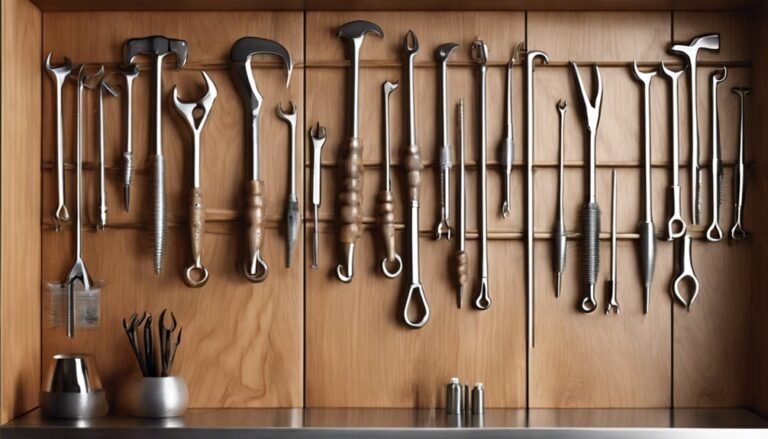How to Use Hooks for Retail Space Optimization
Using hooks for retail space optimization is a smart strategy. They help you utilize vertical space, enhancing product visibility while keeping the floor plan organized. Choose the right type of hook based on your merchandise; for example, single hooks work for lighter items, while multi-prong hooks suit bulkier products. Position hooks at varying heights to catch customer eyes and create dynamic displays. This method not only improves the shopping experience but also encourages exploration and engagement. There's much more to explore about maximizing your retail space effectively.
Understanding the Benefits of Using Hooks in Retail
When you consider how to optimize your retail space, understanding the benefits of using hooks can greatly enhance your strategy. Hooks allow you to utilize vertical space effectively, promoting retail efficiency by maximizing product visibility without overcrowding your floor plan. By hanging items, you create a more organized display, making it easier for customers to browse and find what they need. Additionally, hooks can highlight featured products, drawing attention and potentially increasing sales. This strategic placement can also enhance the overall shopping experience, giving customers the freedom to explore. With the proper use of hooks, you'll not only improve your store's aesthetics but also streamline operations, allowing you to focus on what matters most—serving your customers and growing your business.
Choosing the Right Type of Hooks for Your Products
When selecting hooks for your products, it's essential to take into account both the type of display hooks and their weight capacity. Different hooks serve various purposes, from showcasing lightweight items to supporting heavier merchandise. By aligning your product needs with the right hook specifications, you can optimize your retail space effectively.
Types of Display Hooks
Selecting the right type of display hooks is essential for maximizing the effectiveness of your retail space. Different hook types serve distinct purposes; for instance, single hooks are great for hanging lightweight items, while multi-prong hooks can accommodate bulkier merchandise. Consider the hook materials, too—metal hooks offer durability and strength, while plastic options can be lighter and more versatile. The choice of finish, like chrome or powder-coated, can also impact aesthetics and functionality. By strategically selecting hooks that align with your products and brand image, you'll create a visually appealing display that encourages customer engagement. This thoughtful approach not only enhances product visibility but also fosters an inviting shopping environment, allowing you more freedom to explore creative merchandising solutions.
Weight Capacity Considerations
Choosing the right display hooks goes beyond aesthetics; weight capacity plays an essential role in ensuring your products are showcased safely and effectively. You need to understand the weight limits of each hook type to prevent accidents and maintain a professional appearance. Consider the load distribution when arranging your products; evenly distributing weight can enhance stability and prevent hooks from bending or breaking. Always check manufacturer specifications to match hooks with your heaviest items. If you plan to display a variety of products, opt for adjustable hooks that can accommodate different weights. This strategic approach not only protects your merchandise but also gives you the freedom to experiment with layouts without sacrificing safety.
Creative Ways to Display Products With Hooks
Although hooks may seem like a simple tool, they can transform your retail space into an engaging product showcase that captures customers' attention. To leverage display creativity, consider varied hook designs, like tiered or angled displays, that enable you to present products at different heights. This not only attracts the eye but also encourages exploration. Use decorative hooks to align with your brand's aesthetic, making the display visually appealing. Additionally, group items by theme or color on hooks to create a cohesive look that tells a story. Don't forget to incorporate signage or tags on hooks to provide customers with relevant information, enhancing their shopping experience and guiding their purchasing decisions. This strategic approach can elevate your retail space considerably.
Maximizing Vertical Space With Hooks
Maximizing vertical space in your retail environment can greatly enhance product visibility and accessibility. By implementing effective vertical display techniques, you can draw customers' eyes upward, showcasing more products without consuming valuable floor space. Consider utilizing hook arrangement strategies that allow for varied heights and spacing, making your displays more dynamic and engaging. Group items by category or color, ensuring a cohesive look that invites exploration. Experiment with different hook types and placements to find what best highlights your merchandise. Remember, a well-organized vertical display not only captivates customers but also creates a sense of freedom—encouraging them to browse and discover. In this way, you're optimizing your space while fostering an inviting shopping atmosphere.
Organizing Inventory Efficiently Using Hooks
To organize your inventory efficiently, consider how hooks can optimize vertical space while ensuring easy accessibility. By strategically placing hooks at varying heights, you can maximize product visibility and streamline the shopping experience for your customers. This approach not only enhances organization but also encourages quicker restocking and inventory management.
Vertical Space Utilization
When you consider the limited floor space in retail environments, utilizing vertical space becomes essential for effective inventory organization. Implementing strategic hook arrangements allows you to maximize your display heights, creating an illusion of spaciousness while showcasing more products. Start by analyzing your inventory: heavier or bulkier items should occupy lower hooks for easy access, while lighter items can be placed higher. This not only optimizes visibility but also encourages customers to explore the full range of offerings. Ascertain your hooks are adjustable, allowing flexibility in arrangements as inventory changes. By leveraging vertical space effectively, you gain the freedom to design dynamic displays that engage customers, driving sales while maintaining a clutter-free environment. Embrace this approach, and watch your retail space transform.
Easy Accessibility Solutions
How can you guarantee that your customers easily access your products while maintaining an organized display? Using hooks strategically can enhance customer flow and maximize product visibility. Start by identifying high-traffic areas where you can hang popular items, drawing attention without creating clutter. Organize products by type or size, ensuring customers can quickly find what they need.
Adjust the height of hooks to cater to your target demographic, promoting an inviting experience. Utilize labels and signage to guide customers effortlessly through your space. This approach not only streamlines your inventory but also encourages impulse purchases, empowering shoppers to explore freely. With a well-structured display, you'll create a balanced environment where accessibility and organization work hand in hand, resulting in satisfied customers and increased sales.
Enhancing Visual Merchandising With Hooks
While many retailers focus on product placement and lighting, hooks can play a pivotal role in enhancing visual merchandising. By strategically using hooks, you can create an inviting environment that boosts visual appeal. Hooks allow you to showcase products at various heights, drawing the eye and prompting customer engagement. Consider layering items or grouping them by theme; this not only adds depth but also encourages exploration. Whether it's clothing, accessories, or seasonal items, utilize hooks to keep your displays dynamic and fresh. Additionally, adjusting your hook arrangements regularly can maintain interest and inspire repeated visits. Ultimately, hooks empower you to present your offerings in a way that resonates with customers, fostering a more immersive shopping experience.
Seasonal Displays: Adapting Hooks for Different Promotions
Adapting hooks for seasonal displays can greatly enhance your promotional efforts, especially as customer preferences shift throughout the year. By aligning your hooks with seasonal themes, you create a cohesive and attractive shopping experience. For instance, during the winter holidays, consider using hooks that showcase festive items, drawing attention to limited-time offers.
Moreover, think strategically about your promotional strategies; use adjustable hooks to accommodate varying product sizes and weights. This flexibility enables you to pivot quickly between themes, maximizing your space efficiency. Don't forget to change out signage alongside your displays to reinforce the seasonal narrative. Ultimately, by thoughtfully curating your hooks for each season, you'll not only boost engagement but also invite customers to explore and enjoy their shopping experience more freely.
The Importance of Hook Placement and Design
Effective hook placement and design are fundamental to maximizing the impact of your retail space. You need to strategically consider both hook visibility and hook aesthetics to create an inviting atmosphere that attracts customers. Position hooks at varying heights to draw the eye and keep shoppers engaged, allowing them to see products without obstruction. Use hooks that complement your brand's identity; this enhances the overall aesthetic while providing a cohesive look. Make sure that the hooks are sturdy, showcasing products effectively without compromising safety. By optimizing hook design and placement, you not only elevate the shopping experience but also encourage impulse purchases, thereby driving sales. Remember, a well-thought-out approach to hooks can lead to greater freedom in showcasing your offerings.
Maintenance and Safety Considerations for Hook Displays
Although hooks can significantly enhance product visibility, maintaining their functionality and guaranteeing safety is essential for a positive shopping experience. Regular hook maintenance involves checking for wear and tear, confirming they're securely fastened, and replacing damaged hooks immediately. Adhering to safety guidelines, such as weight limits and proper installation, can prevent accidents and enhance customer trust.
| Maintenance Task | Frequency | Safety Consideration |
|---|---|---|
| Inspect hooks | Weekly | Check for rust or damage |
| Tighten fasteners | Monthly | Confirm hooks are secure |
| Replace damaged hooks | As needed | Avoid overloading |







